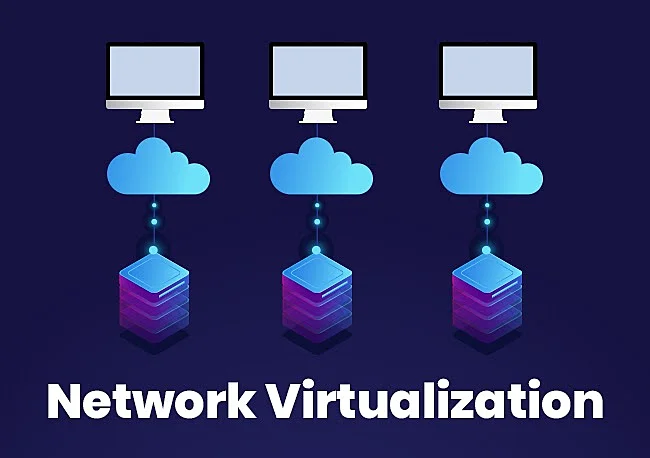What is network virtualization? All the information you need to know
Network virtualization is a technique that combines the resources available in a network to consolidate several physical networks, partition a network, or create software networks between virtual machines. By pooling the resources offered by a network, this is possible.
With the aid of network virtualization, IT teams can create a variety of separate virtual networks that are connected by a common physical infrastructure. Then, these networks can talk to one another. Teams can expand current virtual networks and create new ones without having to change the underlying physical hardware.
Teams can respond more quickly to changes in business requirements by spinning up logical networks since network virtualization removes the need for administrators to manually configure hardware in order to instantiate virtual networks. This flexibility makes it feasible to supply services more quickly while also increasing operational effectiveness and control.
A number of factors, including those mentioned above and others, have hastened the adoption of network virtualization in carrier and enterprise networks. Find out more about the many types of network virtualization, as well as the advantages and difficulties associated with utilising this technology.
How does network virtualization work?
Network services are separated from the underlying physical hardware and infrastructure by means of network virtualization. In order to achieve this, a network hypervisor will provide an abstraction layer, claims Stephen J. Bigelow, senior technology editor at TechTarget. Then, a variety of virtual networks will be hosted and supported by this layer.
The nodes and linkages of the virtual networks, which are utilised to build the networks, are more easily understood thanks to the abstraction layer. The hypervisor is in charge of managing each logical network’s resources, bandwidth, and capacity in addition to abstraction. The virtual networks continue to function independently of one another and follow their own sets of safety regulations even if they share the same hypervisor technology.
Virtual network components, such as virtual machine workloads, are able to communicate not only with one another but also with nodes that are present on other virtual networks thanks to encapsulated host protocols, virtual switches, and virtual routers. Users enjoy substantially less latency because the communications do not go through the actual networking hardware.
Network administrators have the ability to transfer workloads—along with the associated security policies and networking requirements—from one host to another in real time. In addition, the virtualization platform will deploy the required security guidelines for any new workloads right away.
Network virtualization frequently falls into the following categories:
-
Management equipment
-
A network’s hypervisor
-
The controllers’ software
-
In virtual settings, switching and routing
-
Host protocols, including VXLAN (Virtual Extensible LAN)
Why is network virtualization important?
Virtual local area networks (VLANs), overlay networks, and server virtualization are a few examples of how the idea of virtualization has been around for a while. Businesses started applying the principles of virtualization to their data centres as they sought more control over their networks, and they then extended this practise to their wide area networks (WANs) and local area networks (LANs).
If businesses embrace ideas like abstraction, programmability, and microsegmentation, they can scale their networks, add centralised control, and apply unique security policies to workloads and traffic kinds. The network can offer applications and services more quickly thanks to all of these factors, which enables them to satisfy business ambitions.
Performance control, security, and risk management are some of the most common use cases for network virtualization, according to John Burke, CTO and analyst at Nemertes Research. For instance, network virtualization enables network teams to create and enforce security standards in compliance with auditing requirements while also helping them provide enough bandwidth to the necessary resources.
Virtual networks have historically been divided into internal and external types. Both expressions describe how the client’s computer is situated in relation to the server. Switches, adapters, or networks can be used as part of external virtualization to integrate one or more networks into a single virtual entity. By integrating network-like features within software containers that are hosted on a single network server, internal virtualization enables virtual machines (VMs) to communicate with one another on a host without using an external network.
Applications in diverse network areas, such as the data centre, wide area network (WAN), and local area network, make it easy to identify network virtualization projects (LAN).
In data centres, network virtualization is generally credited to software-defined networking (SDN), whereas software-defined wide area networking (SD-WAN) is credited for revolutionising WAN virtualization. The development of LAN virtualization has been aided by companies that have deployed software-defined local area networks (SD-LAN) in an effort to optimise their business processes.These divisions focus on addressing a range of different use cases and are frequently maintained by independent teams. To accomplish an end-to-end network virtualization strategy with built-in zero-trust security, however, enterprises may need to consider how to combine these many initiatives as networking advances. They may need to consider how to consolidate them in light of this.
Network virtualization in the data center
Within data centres, virtual networking has long been used extensively through the usage of VLANs, VPNs, and MPLS. Burke claims that as networks and the threats they present developed, corporations looked for ways to boost network security while simultaneously introducing more management. In response to these needs, SDN was one approach suggested since it paves the way for centralised control and supports designs that are more policy-driven.
Additionally, as virtualization has advanced, new concepts have been incorporated, including “zero trust” in the form of software-defined perimeters and “infrastructure as code,” which refers to the use of software code rather than manual procedures for the configuration and management of available resources. SDP is responsible for enclosing the network in a virtual barrier and relies on identity controls to manage resource access.
Network virtualization in the WAN
The wide area network (WAN), which was one of the last components of the network to adopt virtualization before the creation of software-defined wide area networks (SD-WAN), is now a common practise. Businesses can abstract the many physical connections that are present inside their WANs and assign bandwidth and capacity in a way that is better suited to the needs of individual apps and the organisation as a whole by using SD-WAN.
Burke claims that one of the most important aspects of WAN virtualization is the management of the underlying infrastructure. If network teams do not undertake proper reviews of the providers they use and the locations at which they use them, it is simple for them to fall victim to provider sprawl. The management of contracts, billing, and troubleshooting are other considerations.
Additionally, SDP and zero trust have entered the WAN virtualization space. With the use of zero-trust ideas, SD-WAN may create security partitions that adhere to security rules and only transport authorised traffic. Another factor to take into account is how WAN virtualization integrates with cloud environments, which are swiftly taking over as the preferred hosting platform for company resources and workloads.
Network virtualization on a local area network (LAN)
The construction of separate virtual networks and traffic segmentation are common uses of VLANs in LANs. Burke claims, however, that the local area network (LAN), much like the data centre and the WAN, is undergoing changes as a result of virtualization and SDN.
The same principles of SDN are used by SD-LAN, but in the context of local area networks (LAN). VLANs rely on Ethernet and other Layer 2 protocols, whereas SD-LAN extends virtualization throughout the entire LAN. The system may therefore check access, visibility, users, device identities, IP addresses, and time of day. Burke claims that this makes it possible to apply policies more precisely to the content of the LAN.
Because SD-LAN is compatible with zero-trust methods, a more extensive security architecture that can keep up with emerging developments like the Internet of Things is created (IoT). The combination also streamlines the process of network monitoring and aids in optimising LAN operations. Burke emphasised that there are still issues like working with outdated infrastructure, the price of updating, and improving personnel competencies.
Network Virtualization Security
Security has advanced to the point that it is now a crucial element of any network’s design. It can be difficult for network teams to create security policies that are relevant to the entire network and to guarantee that these policies are implemented because various areas of the network are frequently separated from one another.
Burke claims that zero trust has the power to integrate both those network components and the associated virtualization activities. The zero-trust system is reliant on user and device authentication at every network node. Users on a local area network must first gain authentication in order to access a data center’s resources.
A zero-trust environment combined with network virtualization provides the secure connectivity needed for endpoints to communicate securely. To accommodate the interactions in question, virtual networks can be scaled up or down while maintaining the necessary level of traffic segmentation.
This technique requires the setting of access policies, which specify in detail which devices can communicate with one another and in which places. For instance, the policy must be understood not only at the wide area network (WAN) level but also at the campus level if a device is permitted to access a resource in a data centre. Burke claims that because it can be difficult for teams to determine which entities need to connect with one another, this is one of the most challenging issues that network teams must deal with.
Another challenge is getting various teams to properly collaborate. The network and security teams will need to discuss security guidelines, network requirements, and infrastructure improvements.
Pros and Cons: Network Virtualization
Virtualization of networks has many advantages and according to Andrew Froehlich, president of West Gate Networks and founder of InfraMomentum, the benefits of network virtualization vary depending on the business needs that must be met as well as the locations inside an enterprise’s networks in which virtualization is used. For instance, virtualization within the data centre can assist scalability while also increasing data security through the use of microsegmentation. On the other hand, wide area network (WAN) virtualization is mainly concerned with enhancing the performance of applications and enforcing policies.
The following is a list of general benefits that are commonly associated with network virtualization:
- Operational efficiency
- Improved network security
- Disaster recovery
- Accelerated network installation
- Configuration, cost savings on hardware
Virtualization of networks presents a number of challenges.
However, despite the fact that it helps businesses enhance their overall performance, scalability, and security, network virtualization still presents significant issues. The ease with which network managers can set up virtual networks is one factor that frequently contributes to the phenomenon known as “virtual sprawl.” A common side effect of virtual sprawl is an increase in the amount of resources used and the complexity of the network.
According to Froehlich, some of the other issues associated with network virtualization include the following cultural and technological obstacles:
Alterations are made to the network architecture. When businesses make the transition from relying on physical appliances to relying on virtual networking, they need to perform a cost-benefit analysis to determine how the new architecture might affect their resource consumption, including CPU and storage space, as well as how it might affect their resilience and security.
Separate areas of expertise. Traditional information technology teams are typically compartmentalised into various departments, such as servers, networking, and security. The development of enterprise technologies and the proliferation of virtualization across the several components of the network, on the other hand, necessitate an increase in the level of communication between the various departments of the organisation.
New skills for IT. Staff can anticipate a learning curve as they gain the essential skills to design, administer, and operate various network virtualization technologies. This is because traditional IT and network silos make it difficult to share information.
The visibility of the network According to Froehlich, traditional monitoring technologies run the risk of losing visibility into the abstracted levels when network virtualization introduces more logical layers that cooperate with one another. There is a possibility that network teams will react by implementing network visibility tools, which will further add to the tool sprawl that is typical of enterprise networks.
The use of AI and automation. In addition, network virtualization can bring automation and artificial intelligence tools into the network. According to Froehlich, these tools not only make network management better, but they also call for the establishment of brand new protocols and procedures, which must be recorded. Teams working on networks have the responsibility of ensuring that their automation and AI initiatives are compatible with one another. In addition, the combination of AI and automation may uncover cultural hurdles that require modification.
Examples of network virtualization
VLANs and VPNs were two of the earliest types of network virtualization that were implemented. Because of the proliferation of virtualization use cases across the network, businesses gradually embraced SDN principles in their data centres, wide area networks (WANs), and local area networks (LANs).
According to Tom Nolle, president of CIMI Corp., carriers deploy feature virtualization and network virtualization to efficiently deliver services to enterprise customers. This information was provided by Tom Nolle.
The architecture of network functions virtualization (NFV) is the primary emphasis of a carrier strategy for feature virtualization. Through the use of NFV, various functions, such as load balancing, routing, and firewalling, are hosted on virtual appliances or commodity hardware rather than being performed on dedicated hardware devices.
Because of this flexibility, carriers are able to load specific feature software onto general purpose equipment, and then deliver services in the form of virtual network functions (VNFs). If carriers want to grow their portfolios, rather than needing to buy specialist hardware and then figure out how to use it at scale, they can just build new software instead and increase their offerings that way.
According to Nolle, carriers are also looking into new network virtualization technologies such as slicing 5G networks, cloud computing, and edge computing. Through the use of a technology known as network slicing, carriers are able to partition their physical infrastructure into a number of distinct private networks catered to their various customers, each of which possesses its own set of capabilities and must meet its own set of security requirements. Hosting and delivering the various features and services that consumers require, edge computing and cloud computing are efficient and flexible alternatives to on-premises methods. These strategies host and provide the features and services that are closer to where the customers use them.
The virtualization of networks will continue to be an essential component in the designs of networks for businesses and for wireless carriers. Going future, activities pertaining to network virtualization will invariably incorporate zero trust, automation, edge computing, and cloud computing.
 ADREVIA
ADREVIA










Adrevia Editor Team
A team of editors and writers who are passionate about writing and editing articles. The team is mainly responsible for creating engaging articles for our users and providing more information on how businesses can be improved with writing.